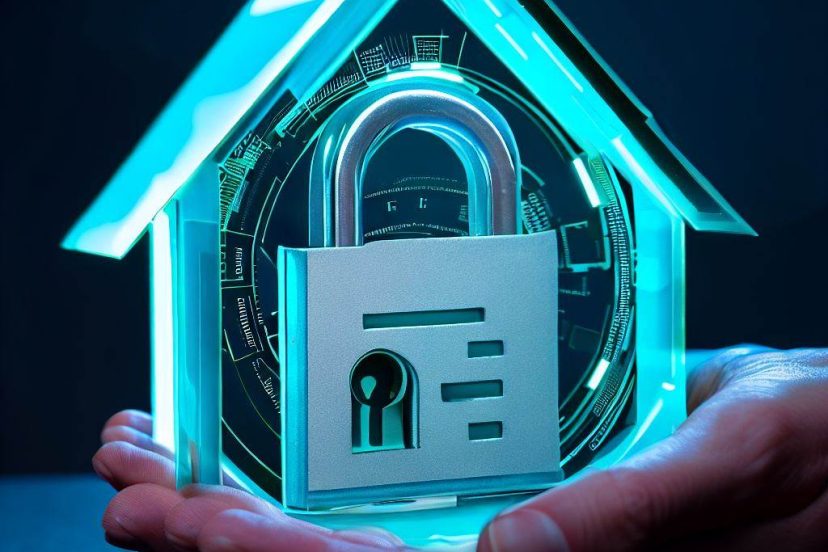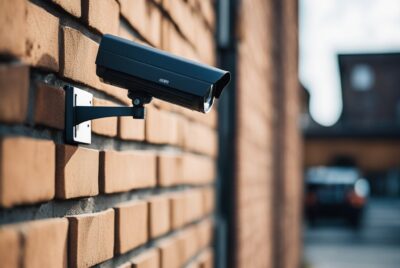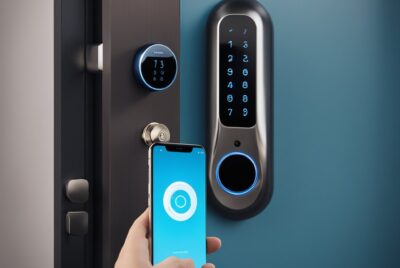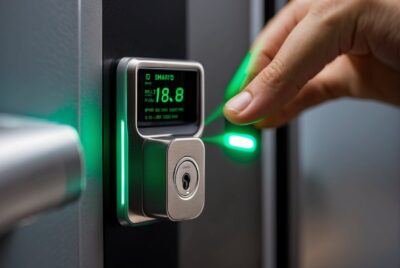What is NOT a Physical Security Measure for Your Home?
*We may earn a commission for purchases made using our links. Please see our disclosure to learn more.
What is NOT a Physical Security Measure for Your Home? Unveiling Common Misconceptions
So what is not a physical security measure for your home? Let’s find out! When it comes to securing our homes, the measures extend beyond locks and alarms. While physical security measures such as fences, locks, and security guards play a vital role in protecting a property, there are other elements that are just as crucial, yet not as tangible. These non-physical security measures often involve technology and cybersecurity, and are aimed at creating a comprehensive, holistic approach to home safety.

I consider non-physical security measures to encompass the digital or procedural strategies that bolster the effectiveness of physical ones. For instance, cybersecurity measures like antivirus software, firewalls, and strong password protections are essential to safeguard against digital intrusions that could compromise my home network and connected devices. Similarly, home automation systems can provide remote monitoring capabilities, giving me real-time alerts and the ability to respond quickly to potential threats, even when I’m not physically present.
Understanding the interplay between physical and non-physical security strategies allows me to take a more rounded approach to protecting my home. It’s not just about the physical barriers I put in place, but also the technological and procedural defenses that address aspects of security a burglar alarm or deadbolt simply cannot. This dual focus is crucial in an era where threats can as easily come through a Wi-Fi network as through a window.
Understanding Physical Security

In assessing the security of our homes, it’s imperative that we clearly differentiate between physical and non-physical security measures. This will ensure that we have a layered approach that encompasses both visible deterrents and more strategic elements.
Defining Physical Security Measures
Physical security measures are tangible protections designed to prevent unauthorized access and protect property from damage or theft. These measures act as the first line of defense in home security. I characterize them by their physical presence; they are aspects you can touch and see. They often serve as barriers to entry or means of surveillance.
- Access Control: Physical security begins with controlling who can enter your property. This includes locks on doors and gates that require proper credentials to open.
- Barriers and Fences: Erecting walls, fences, or other barriers to entry adds another layer of security by deterring intruders and limiting points of entry.
Common Physical Security Elements
Physical security components are the nuts and bolts of safeguarding our homes. They are on the front lines, warding off potential intruders and providing peace of mind through their mere presence.
- Locks: High-quality locks are essential for securing doors and windows. They are among the most basic, yet crucial, physical security measures.
- Doors and Windows: Strong, well-maintained doors and windows are critical, as they often present the first target for intruders attempting to gain entry.
- Surveillance Cameras: These devices provide real-time monitoring and recording of activity around the home, often deterring criminals simply by their visibility.
- Lighting: Adequate exterior lighting is important for both visibility and as a deterrent, as it can expose intruders and make them think twice before approaching.
- Security Systems: Including alarms and sensors, these systems alert homeowners and authorities of any breach, adding both a psychological and practical layer of security.
- Physical Barriers: Beyond fences, additional physical barriers might include window grills, deadbolts, and security screens.
Through these elements, you can create an effective physical security system for your home that discourages intruders and helps protect your assets and loved ones.
Technology and Digital Solutions

In addressing home security, I find it essential to distinguish between physical barriers and the increasingly vital digital defenses in smart homes. My focus here is the often-overlooked, yet equally important, digital security measures.
Misconceptions About Digital Security
Many homeowners believe that strong locks and surveillance cameras are comprehensive security solutions. However, as smart homes integrate more Internet of Things (IoT) devices, cybersecurity measures become indispensable. I want to make it clear that digital defense goes beyond antivirus software; it encompasses a strategic approach to protect against online threats. This includes regular security patches, ensuring all devices within the smart home ecosystem are up-to-date, thus mitigating vulnerabilities that hackers might exploit.
Role of Technology in Home Security
I leverage technology in home security to add layers that physical measures alone can’t provide. For example, multi-factor authentication (MFA) offers an added level of protection when accessing my home’s smart systems. Data encryption is another tool at my disposal, ensuring that sensitive information transmitted by smart home devices remains inaccessible to unauthorized parties. I also incorporate cybersecurity measures to equip my digital domain against cyber threats. Here’s how I integrate these components:
- Smart Home Devices: I connect devices securely, using robust passwords and changing them regularly.
- MFA: I apply Multi-factor authentication to my home network, which requires at least two evidences of my identity before granting access.
- Data Encryption: I ensure that data encryption protocols are implemented for my Wi-Fi network and smart devices, safeguarding the data they handle.
- Security Patches: I stay vigilant by installing updates and patches for all my connected devices as soon as they’re available.
By doing so, my home’s digital safety net works cohesively with physical security, creating a comprehensive defense system.
Community and Environmental Measures

In assessing home security, I often emphasize the significance of both community engagement and environmental design. These non-physical measures, while not directly altering the structure or hardware of the home, play a crucial role in its overall security.
Leveraging Neighbors and Community
Neighbors as Watchdogs: I understand the importance of cultivating strong relationships with my neighbors. Engaged neighbors can function as a de facto neighborhood watch, keeping an observant eye for any unusual activity and promptly reporting it. This communal vigilance significantly enhances the security of my home, as well as the entire neighborhood.
- Community Association Involvement: By actively participating in my local homeowners’ association, I further fortify my home’s security. The association often organizes meetings where we discuss and implement security measures beneficial to our community, such as lighting strategies and the maintenance of clear sight lines.
Environmental Design for Security
Strategic Placement of Landscaping: I recognize that the way I design and maintain the environment around my home can affect its security. For example, ensuring that bushes and trees do not provide concealment for potential intruders is essential. Maintaining a clear visual field from the street to my home deters unauthorized access.
- Lighting as a Deterrent: Utilizing outdoor lighting effectively is another strategy I employ. A well-lit exterior reduces hiding spots for potential intruders, making my property less appealing to them. Solar-powered lights along walkways and motion-sensor floodlights are just a few examples of how I use lighting to enhance security.
By integrating these community-oriented and environmental strategies, I enhance the security of my home without relying solely on physical barriers or devices.
Behavioral Strategies and Vigilance

In aiming to protect my home from potential threats such as unauthorized access, break-ins, and burglaries, I understand that physical measures are not my only defense. Behavioral strategies and a vigilant mindset play a crucial role in minimizing the opportunity for these threats to materialize.
Importance of Awareness
My first line of defense is maintaining awareness of my surroundings. I make it a point to note unusual activities and unfamiliar faces in my neighborhood. Participating in neighborhood watch programs has helped me stay informed about local incidents and foster awareness among my neighbors as well. For instance:
- Keep an Eye Out: I observe for signs of surveillance or strange behavior around my area.
- Communication: I share information about potential threats with my neighbors to enhance collective vigilance.
Staying informed about the latest tactics used by burglars empowers me to better recognize when my home might be targeted.
Avoiding Predictable Patterns
Burglars often look for patterns or routines that make my home an easy target. To combat this, I vary my daily routines to reduce predictability. This includes:
- Changing the times I leave and return home.
- Having a friend collect my mail when I’m away, to give the impression that the house is occupied.
- Using smart home technology to switch lights on and off at varying times during the evening.
By doing so, I greatly diminish the chances of my home being targeted by opportunistic criminals. My aim is to project the message that my home is not an easy mark for unauthorized access, thus potentially deterring would-be offenders from considering it as a target.
Non-Physical Preventative Measures

In securing my home, I recognize that not all safety measures are tangible. I focus on protocols and cybersecurity to create a comprehensive defense against various threats.
Incorporating Non-Physical Security Protocols
To enhance the safety of my home, I adopt specific security protocols that aren’t physical in nature. This involves establishing and following a set of guidelines to ensure consistent security practices are maintained. Established policies might include how I handle the distribution of spare keys or the process I go through when hiring domestic help to avoid any potential inside threats.
I also recognize the importance of staying vigilant against social engineering attacks. These are deceptive tactics used by criminals to manipulate individuals into giving out confidential information. To guard against these and other threats like phishing scams, I’ve set clear rules for how my family and I handle unexpected requests for personal information, whether via email, phone calls, or in person.
Cybersecurity as a Safety Layer
Given that my home is equipped with various internet-connected security devices, I acknowledge that digital security is essential. To safeguard my home network, I use strong, unique passwords and enable multi-factor authentication to prevent unauthorized access.
To protect my devices from viruses and hackers, I ensure that antivirus software and firewalls are up to date and active. Aware that threats often evolve, I regularly update these systems for maximum security. Additionally, implementing a Virtual Private Network (VPN) on my home network encrypts data transmission, shielding my internet activities from prying eyes.
For security measures that provide real-time alerts and remote monitoring capabilities, I make sure they are integrated with my digital security ecosystem. This way, if any of my devices detect an issue, I receive immediate notifications on my smart devices no matter where I am, allowing for a rapid response.
Frequently Asked Questions
In discussing home security, it’s crucial to distinguish between effective physical security measures and common misconceptions that do not contribute to the safety of a home.
1. What practices are considered ineffective for home physical security?
Leaving a spare key hidden on the property, often under a doormat or in a flowerpot, is widely regarded as an ineffective security practice. It can inadvertently provide easy access to potential intruders.
2. Which items are commonly misconceived as physical security measures for residences?
Items like imitation security cameras or dummy alarms are often misconceived as effective. Thieves can sometimes distinguish between real and fake devices, rendering the faux options ineffective.
3. What is considered a cybersecurity measure rather than a physical security measure at home?
Using strong passwords and installing antivirus software on home devices are common cybersecurity measures. They protect against digital threats but do not contribute to the physical security of a home.
4. What are examples of security features for electronics that do not enhance home physical security?
Features such as remote wiping or tracking of electronics might protect the data on your devices, but these do not physically secure your home against unauthorized entry or theft.
5. Which home comfort upgrades are often mistaken for physical security improvements?
Home automation systems that control lighting, temperature, and appliances can offer convenience and the illusion of occupancy, but in themselves, they do not strengthen the home’s physical barrier against intruders.




